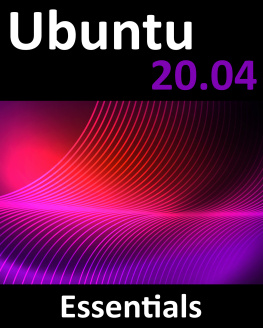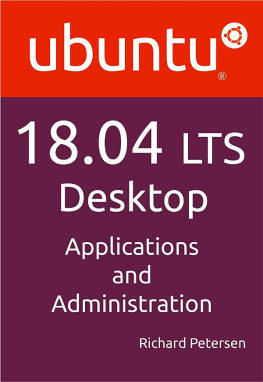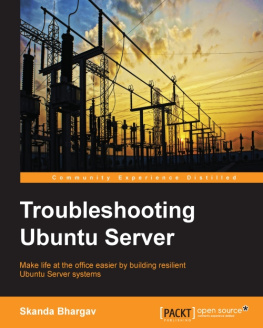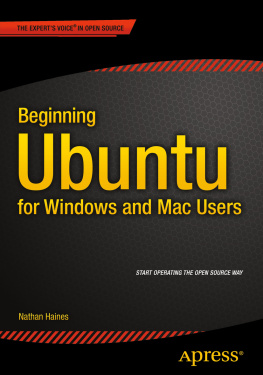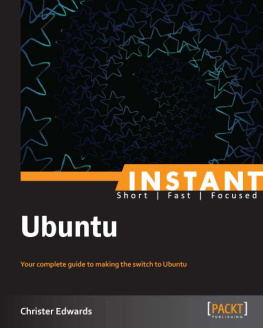Get Started with Ubuntu 19.04
Disco Dingo
Get Started with Ubuntu 19.04 Disco Dingo
Copyright 2019 Matthew Vogel
Ubuntu is a registered trademark of Canonical Ltd.
Linux is a registered trademark of Linus Torvalds
All other trademarks used in this book are the property of their respective holders. Use of any trademark in this book does not constitute an affiliation with/or an endorsement from the trademark holder. The use of the Ubuntu trademark does not constitute an affiliation with/or endorsement by Canonical or the Ubuntu project. Rather than put a trademark symbol after every occurrence of a trademark name, we use names in an editorial fashion only, and to benefit the trademark holder, with no intention of infringement of the trademark.
All information in this book is presented on an as-is basis. No warranty or guarantee is provided and the author and/or publisher shall not be held liable for any loss or damage.
Table of Contents
Table of Contents
1. Introduction
1. Introduction
1.1 What this book is
This book is a beginners guide to installing and using Ubuntu 19.04 Disco Dingo , the newest version of the popular Linux distribution. This book was written for a new Linux or Ubuntu user.
This book is an update from my previous book covering Ubuntu 18.10 released earlier this year.
1.2 What this book is not
This book is not an exhaustive guide to the Linux operating system. I do not want to overload a new user to Linux so my goal is to keep this book relatively simple and geared toward the new Linux user and tackle more advanced topics in other books.
This book is not professionally edited. I am basically a one man show with a full time job in the Network Security field, a part time job teaching Network Security at night, a part time photographer, and part time writer. While I have done my best to find my mistakes, this book will have spelling and grammar errors, I promise. If you find one let me know and I will make sure to fix the problem in the next edition. You can email issues to .
1.3 What is Ubuntu
I am not going to waste a lot of time explaining what Ubuntu is and where it comes from. You can read all about Ubuntu on their Wikipedia page at http://en.wikipedia.org/wiki/Ubuntu_(operating_system) .
I will tell you that Ubuntu is a form of Linux which is a free operating system that is Unix-like. My guess is that you already know that or you would not be reading this book.
1.4 Why I like Ubuntu
I have been using Linux for about 16 years and using Ubuntu for about 9 years. I really like Ubuntu's ease of installation and ease of use once installed. Ubuntu also tends to include a lot of leading edge technology in their releases which means that it runs on a lot of the newer hardware without having to worry about installing special drivers.
For a beginning Linux user you cannot go wrong with Ubuntu.
1.5 Getting Ubuntu
You can download Ubuntu directly from their website at http://www.ubuntu.com . On the main page click on the download tab and then click on Ubuntu Desktop. You can also download a Server version and a Cloud version but these versions are outside of the scope of this book so I suggest you stick with the Desktop version.
You will be downloading an ISO file which is a DVD image file.
1.6 How are you going to install Ubuntu
There are many ways to use Ubuntu. Some of the options are:
1.6.1 Live DVD or USB
If you are going to use the Live DVD then you will have to burn the ISO to a DVD, not a CD as the ISO is too large for a CD. If you are going to use the Live USB you will need an 8GB or bigger USB thumb drive and a utility to create the Live USB . There are several utilities on the Internet for burning an ISO to a DVD or USB Thumb Drive. Some operating systems come with utilities that allow you to burn an ISO image to a DVD or create a bootable USB from an ISO image. Figure 1-1 shows the Startup Disk Creator that comes with Ubuntu. You have to provide a source ISO and a USB device to burn the image to.
Figure 1-1. Startup Disk Creator
The Live DVD or Live USB allows you to boot into Ubuntu without installing the operating system to your hard drive, sort of like try before you buy. You will have the option to install the operating system from the Live DVD or Live USB once the operating system boots. In order to boot from a Live DVD or Live USB you need to adjust the boot sequence in the BIOS to allow booting from the DVD or USB device.
For most systems you will need to interrupt the boot process by pressing F2 or F12 on your keyboard to enter the BIOS. There will be a message that is displayed for a few seconds right at the start of the boot sequence that will tell you which key to push. Some BIOS also allow you to choose the boot device without editing the BIOS. Once you are in the BIOS look for a tab or section labeled Boot. This is where you will be able to change the boot options. Be sure to save your changes before you exit the BIOS.
Figure 1-2 shows the Boot tab of a system BIOS utility. Depending on your system you may have to rearrange the boot order to get the DVD or USB to boot.
Figure 1-2. Bios Boot Order
1.6.2 Install to the hard drive
If you install the operating system to your hard drive you can either use the whole hard drive for Ubuntu or you can dual boot between Windows and Ubuntu or Ubuntu and another flavor of Linux.
In order to install a dual boot system with Windows and Ubuntu you should install Windows first and then install Ubuntu. You also need to have enough unallocated space on the hard drive to hold the Ubuntu system. Dual boot configurations are covered in .
1.6.3 Virtualization
Virtualization is an option that allows you to keep your existing operating system and run Ubuntu in a Virtual Machine (VM). This is the method that I recommend for beginning Linux users unless you have an older laptop or PC that you do not use as your primary desktop. I personally run Ubuntu in a VM at home and at school when I teach. I also have a dedicated Ubuntu laptop.
If you want to use Virtualization I recommend using VirtualBox, Figure 1-3. You can download VirtualBox for free from their website https://www.virtualbox.org . If you are going to use Ubuntu in a VM you do not need to burn the ISO to a DVD or USB thumb drive. You only need to download the ISO and point the VM at the ISO as the boot media and off you go.
Figure 1-3. VirtualBox
1.6.4 UEFI Secure Boot
When using installing Ubuntu on a system that supports UEFI Secure Boot, it is recommended that you disable Secure Boot. Some software will not work properly with UEFI Secure Boot enabled.
1.7 Long Term Support (LTS)
Ubuntu 19.04 is not a Long Term Support (LTS) version. Ubuntu 18.04 was the last LTS version. A new version of Ubuntu is released every 6 months with an LTS version released every 2 years. A non LTS version will be supported with updates and security patches for 9 months and an LTS version will be supported for 5 years. For businesses using the Ubuntu LTS version on servers and desktops the longer support removes the need to upgrade every 6 to 9 months.













